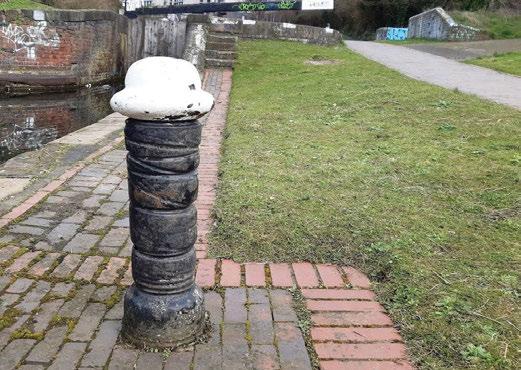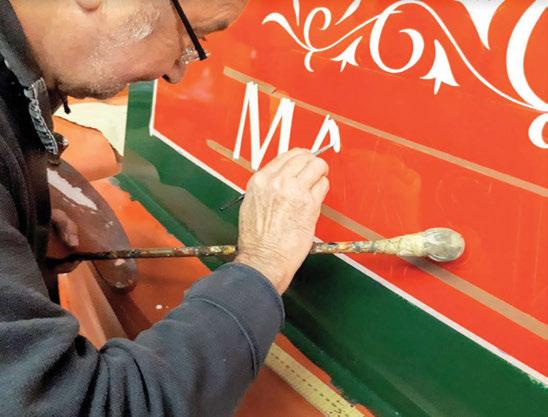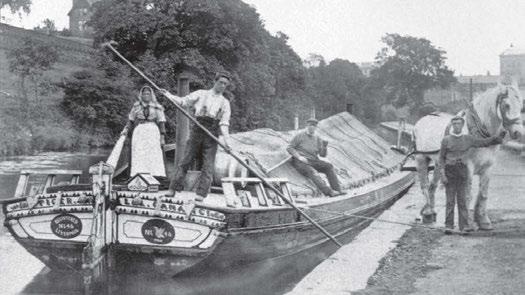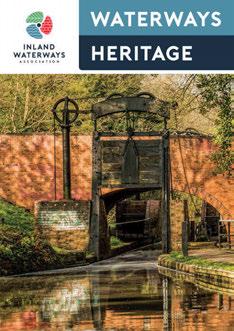
10 minute read
Campaigns Update
CAMPAIGNING WITH YOU
The ban on the use of red diesel for propulsion and UK’s 2020 Environment Bill are among some of the issues we’ve been campaigning on with your help. Here’s how we’re doing on these and other affairs…
IWA’s vision for sustainable boating Red diesel consultation
IWA’s Sustainable Boating Group has published a vision paper outlining initiatives that could ensure boats on the inland waterways don’t get left behind in the country’s progress to zero CO2 emissions by 2050. If implemented, the proposals would go a long way to ensuring that our canals and rivers continue to deliver benefits to society and the economy, and will be sustainable for future generations.
Proposals Include:
Investment in infrastructure – the installation of 300 shore power mains connection charging sites across the inland waterways network (as a starting point, investment on other waterways should follow). This would improve air quality by reducing the emissions from stoves for heating and engines run for charging batteries, as well as enabling a move towards more boats with electric propulsion. National dredging programme – working with navigation authorities, investment in a dredging programme across the inland waterways to make propulsion more efficient. This will also have additional environmental benefits on water quality and increase capacity for flood waters. Research into biofuels – as existing boats and engines can have lives of 50 years and more (and the manufacture of new engines causes greater ecological and environmental damage than a lifetime of running existing engines) research into the production, use and distribution of biofuels is essential to significantly reduce the environmental impact of existing diesel and petrol engines. Alternative propulsion methods – research and development of alternative forms of propulsion, including hydrogen production and distribution, hydrogen and solid oxide fuel cells, and the use of supercapacitors, will allow these technologies to be developed and trialled in new-build boats.
More details are available in IWA’s Sustainable Boating Vision Paper.
Environment Bill
IWA has responded to the Environment Bill, which is currently going through the parliamentary bill process, by submitting comments on heritage, air quality, water resources and biodiversity net gain.
In the Submission, IWA:
• Stressed the importance of built heritage as well as natural heritage, which we believe is not fully taken into account in the Bill.
• Highlighted that emissions from boats on the inland waterways are relatively small compared to other sources countrywide, but cannot be ignored if the UK is to reach zero CO2 emissions by 2050. The widespread provision of shore power mains connection charging sites would be a key way of addressing this. We also outlined the other findings of IWA’s Sustainable Propulsion Group’s vision paper, which was included as an appendix.
• Raised concerns about the impact on navigation authorities and restoration societies working to bring canals and formerly navigable rivers back into full use. The increasingly complex application processes are often viewed as merely bureaucratic exercises, and the licence costs and permit fees charged to these groups can be financial burdens.
• Outlined IWA’s view that biodiversity net gain is an opportunity to demonstrate the valuable role that waterway restoration plays in the enhancement of habitats and increase of flora and fauna across the country. A number of suggestions were put forward for how biodiversity net gain credits could benefit waterway restoration schemes.
Red Diesel Consultation
IWA has submitted its response to HM Treasury’s consultation on removing access to red diesel for propulsion on the inland waterways from April 2022.
In line with its work on sustainability, IWA’s view is that increased use of biodiesel would be more effective in the longer term in reducing emissions, and red diesel should therefore be retained until there is wider distribution and use of biofuels. IWA also considers that the cost to Government of introducing and managing the proposed change is likely to be in excess of any additional income from the increased taxation.
A key concern of the proposals is the impact on suppliers (including boatyards and fuel boats) and the likelihood that many businesses may decide to stop selling diesel altogether, making it difficult to obtain fuel in some areas.
IWA has also objected to waterborne freight not being given the same right to continue to use red diesel as railways, as this is likely to drive more cargo on to the roads. Roving fuel boats will see increased operating costs, despite the essential service they provide, threatening a loss of livelihoods as well as an important aspect of living waterways heritage.
IWA welcomed the proposed tax relief on any white diesel used for domestic use, with the supplier becoming responsible for claiming the rebate rather than the current self-declaration process. Previous research indicated that 60% for propulsion and 40% for domestic requirements reflects typical fuel use, but IWA’s view is that the new relief scheme should allow a flexible rate to accommodate fluctuations throughout the year, and variation between boaters who use a lot of fuel for propulsion and those who use less.
While boats with separate tanks could continue to use red diesel for non-propulsion uses, it is unlikely that suppliers would continue to sell both types of diesel. There is also concern that although boat-owners will not be required to flush their tanks to remove any red diesel dye, it is proposed that suppliers will have to flush their tanks and IWA considers this unnecessary and unhelpful.
IWA also highlighted the increased costs to registered charities (who were previously able to use red diesel at the full rebated rate) for carrying out their charitable purposes (e.g. getting disadvantaged or disabled children afloat or operating trip-boats to raise funds for restoring a waterway restoration), and has suggested that they should also be exempt.
Spotlight on...
WATERWAYS HERITAGE

A new IWA campaign highlights the importance of our canal and river network’s rich, diverse history
Preserving the right to navigation and maintaining the historic infrastructure of our inland waterways have been at the heart of IWA’s aims from the beginning. A new campaign launched this year, seeks to highlight living heritage on the canals and rivers, as well as the continuing importance of preserving historic waterways assets for the enjoyment of future generations.
Part one of the Waterways Heritage report, published in September, builds upon IWA’s Value of the Inland Waterways by Nicki Schiessel Harvey (released November 2019), which showed that more work was needed to recognise these unique assets. In its broadest sense, waterways heritage can bring a multitude of benefits to local communities as well as boaters. In recent years, canal regeneration has been a catalyst for economic growth, and the tourism industry is thriving as many people are choosing to holiday closer to home. Waterways are free and easy to access, provide opportunities for volunteering and skills development, and offer sustainable modes of transport for living and trading. Underpinning all of this are the historic structures, cultural traditions and collective memories of the canals and the people who once worked them.
Built heritage
navigations are home to over 2,700 listed structures, 70 ancient listed monuments and five UNESCO world heritage sites. Think as big as the Pontcysyllte Aqueduct on the Llangollen Canal and as small as a World War II pillbox on the Kennet & Avon.
Constructed as individual and independent carrying routes, our canals each have their own unique infrastructure and design. To the untrained eye, many locks look the same with their blackand-white painted beams and mitred wooden gates. But compare the lock mechanisms requiring a windlass on the Grand Union Canal to the handspike-operated paddles on the Calder & Hebble Navigation, for example, and it is easy to understand how these variations could be lost if they weren’t given proper consideration during maintenance and restoration works. The same goes for the multitude of bridges, aqueducts, lock-keeper cottages, pumping stations, wharves and docks across the network.
There are also smaller details and artefacts that facilitated travel on the canals during the days of carrying, some of which are still relevant and useful today, others acting as reminders of times gone by. Wet and gritty towing lines from horses or between craft could cause considerable damage to unprotected stonework, so iron guards were fitted or rollers installed in areas of high traffic. Where these still exist, the markings caused by the ropes are important indicators of our working waterways. It’s vital that the public, developers and local authorities have an awareness of these often unnoticed and under-appreciated characteristics.

Rope marks on a strapping post tell us about how the waterways were once used.

Signwriter Dave Moore. Skills and cultural traditions are important aspects of living heritage.
Living heritage

Less obvious aspects of our waterways heritage can be brought together under the umbrella term ‘living heritage’. This applies to the everyday operation of our inland waterways, working boater culture and specialist skills related to boats and boating.
Traditional roses and castles artwork is commonly known beyond canal communities; however, the techniques for painting in this s le must be passed on through the generations so that they don’t get lost in time. The same can be said for signwriting skills and heritage boat-building techniques that ensure ongoing maintenance and repairs to existing historic cra are carried out in such a way as to not damage the integri or aesthetics of the original designs.
The distinct culture of the working boat people, which developed in isolation om land-based communities due to their nomadic lifes le, is equally deserving of our a ention. The language of boaters, om the names given to equipment, skills and places, to that used in their music and stories, risks being lost if it falls out of use or is le unrecorded. Hawkesbury Junction on the Coventry Canal, for instance, has an o cial name arising om its geographical position (close to the village of Hawkesbury), but was be er known to many boat people as Su on Stop a er the family of lock-keepers who resided there in the 19th century. There are hundreds of colloquialisms like this across the network, and it’s likely many more are already lost having disappeared om the boating vernacular as canal carrying ceased and waterways were closed.
Canal enthusiasts with a particular interest in heritage are essential to preserving these techniques and cultural traditions through events and the formation of groups or societies; however, as the waterways have evolved for use by leisure and residential boaters, people have found new ways in which to put into practice old skills. One example is where single-handed boaters use towing techniques, such as bow-hauling, developed by carriers for which the old splits in bridges are vital. Here we can see how living heritage is reliant on built heritage, and vice versa.
Risks
While parts of our inland waterways are protected as places of special historical, architectural or scientifi c interest through various schemes, there remain many hundreds of miles of canals and rivers, plus their related buildings or artefacts, that are not safeguarded in any way. O en there is confl ict between retaining heritage assets and maximising development value of waterside sites, while small details and changes to the aesthetics of rural and urban landscapes can be overlooked.
Built heritage also needs protection om environmental damage. Increasingly volatile weather as a result of climate change puts structures at risk of fl oods and breaches, while the continuing spread of certain invasive, non-native species of plants and animals, such as Chinese mi en crabs and Himalayan balsam, increases the potential for bank erosion.
Future
Waterways heritage is diverse and wide-reaching, so there’s no one-size-fi ts-all approach that can be applied to preserving it. Through the report, we are calling upon navigation authorities, councils, planners, developers and builders to consider heritage as they make plans for the future of our waterways and the features that surround them. Seemingly small changes can have a much bigger impact on the broader heritage but by consulting specialists developers can a empt to understand and mitigate any potentially detrimental e ects before it’s too late.
Part two of the Waterways Heritage report, due for publication in 2021, will contain more detailed guidance and resources, including case studies demonstrating what lessons have already been learned and best practice suggestions for allowing our canals and rivers to continue to be treasured assets in an evolving world.
Download part one of the Waterways Heritage report now at waterways.org.uk/ campaigns/listing/waterwaysheritage-campaign. If you have any questions or concerns regarding waterways heritage, or would like to suggest a site suitable for use as a case study in part two of the report, please contact amy.tillson@waterways. org.uk.










